Flatland Freq’s editor Luke gets his feet wet with the awesome orgnwrms script (by andrewcs_ 🪱) for Monome Norns open-source sound computer and appreciates the contrast and interplay of the analog vs digital FM between the two instruments.
Tag: sidrax
Luke Sanger exclusive live session for Electronic Sound Magazine has been released on their website. In this set he used a Make Noise Shared System and Ciat-Lonbarde Sidrax for a 20 minute improvisation. Subscribers have access to the full set.
Read more about it and access the full set here

All bananas are created equal (or not).
Included in my Ciat Lonbarde (CL) mega-swap (as mentioned in this previous blog), was a big bundle of banana cables and also the means to make my own, with a couple of extra looms and bags of plastic connectors. One thing I noticed when patching these, was connections would occasionally drop out, or not sit properly and need an extra wiggle. Having no previous experience with CL gear, I assumed this was the just the nature of the beast. Anyway, by chance, I stumbled on a good deal on some Buchla branded cables. These still were not cheap by any stretch, but I thought I’d give ‘em a shot and well, the difference is like night and day. It’s a real pleasure to patch these things, far more satisfying than the little clicky Eurorack cables I’d used in the past and vastly superior to the cheap DIY bananas I was using before. So anyway, the adage “buy cheap {bananas}, buy twice” appears to ring true…


Wild plum butter
To someone who’s spent a significant portion of their life, longer than is probably worth admitting, making (and dancing to) weird techno records, on paper, the Plum Butter (PB) at least treads some familiar territory, albeit through a pair of backwards binoculars. Mixer? Sequencer? Pulses… DRUMS even?! I say ‘on paper’, of course there is no paper manual and a word of advice: if you value your paper and ink supplies (and sanity?), just avoid trying to actually print anything off the Ciat-Lonbarde website.
PFlaumenus
When I went to pick up the boxes from my friends and get a little demo, I stared at the PB in a mixture of awe and confusion. Even after reading and watching as much information I could, there were still so many questions! Why is it upside down, or is it? Brown are inputs and outputs? Wahh. The fog cleared pretty quickly when I was told the the basic theme for ins and outs (hot colours out, cold colours in).
As mentioned previously, I’d never played any CL gear in the past, but I’m aware there have been previous iterations of some boxes. In this regard, the PB feels very developed conceptually and operationally, with there being at least one major revision before this version (V2). The user interface informed by geographical design and the signal/traffic flow between city, suburbia and the wilderness starts to make sense when you use the thing, rather than seemingly abstract words on a screen (like I said, don’t bother trying to print that shit).

The space between the speakers
As with most of the ‘commercially’ (ie non-DIY offerings) available CL boxes, audio outputs are delivered via hard panned stereo minijacks. The sound engineer in me internally revulsed at the prospect of these expensive boxes favouring such an inferior connection, but in practice they sound and work OK. Memories of fixing broken jacks on old Walkmans, minidisk players and more recently, my OP-1, will forever haunt. As such, the thought of taking this equipment out live (if live music will ever actually happen again in this part of the world), with the main outputs solely based on such a weak-ass connection, is slightly unnerving. Yes people, I am making a critical comment on a widely respected piece of music tech equipment (shock, gasp, how very DARE he!).
Keep it in the family
So, as discussed, these boxes are designed to play nicely together and I can see how the minijacks aid this cross-pollination of devices (or of course, you CAN use the banana outputs from various modules too, however this would bypass the PB’s internal mixer etc). Many internet content providers tend to daisy chain these boxes directly into one another, in an incestuous orgy of CL instruments (coming from Norfolk, yeah, I can spot it) which certainly looks aesthetically pleasing in 4K (and on instagram), but without some extensive modulation patching, you are in danger of making tracks that sound like those early 70’s records where they have first discovered panning and need to put EVERYTHING in dizzying hard left/right (shudder). I’ve been getting amazing results routing everything into separate mixer channels (using splitter cables) and working that way. Different strokes for different folks and if somehow that makes the music less puritan to thy sacred church of CL, then so be it.
Drum village
In terms of effects, I’ve never been a huge fan of drenching tracks in reverb, however the PB sounds simply UNREAL piped into real spring reverb. Something about the combined industrial effort of these drum villages really excites the springs In my Great British Spring like nothing I’ve put through it before.
Anyway, there’s so much info and opinion out there on the PB, I’m not going to do a guide on how it works, as part of the beauty of these seemingly obfuscate designs, is exploring your own path. Personally, the more I work with it, the more I’m drawn into the dichotomy between industrial and wilderness, which resonates with the choices in how I currently choose to live my life; in a small city, but close to the countryside.

Plum(b) it in and see ‘wha happen?’
A couple of basic (but fun) tricks I’ve not seen explicitly shown elsewhere:
- The snare drum can become many different percussive sounds by means of the yellow (ultra-sound) outputs patched into the blues, this can add all manner of useful harmonic overtones to the noise. This applies really to the blues on all the modules, but is easily exemplified first with the noise source.
- After syncing the man with red steam to an external clock (such as the Cocoquantus as described before), the rolz can also take a pulse from one of the sequencer steps, I’ve had some nice clock division-esque results in this way. Further connecting one rolz to another, keeps the rhythm section somewhat unified.
- Patching into the mixer gives some nice panning effects. In fact lots of the blue appear to influence the stereo field, affecting modules’ left and right permutations (gongue, AV dog, ultrasound etc). So if you are purely using CL gear without a mixer, I would suggest paying attention to these modulations, to fill the stereo field.

The PB audio inputs are really useful and much documented/discussed elsewhere online. I need to spend more time with them admittedly, but the guttural, wheezy tone the filters impart to an audio input is the kind of thing that keeps me distracted from my day job. Imagining the potential sonic terrains I’m going to traverse on my next visit to PB-town. Speaking of which, I have two albums going to mastering this month written solely on this setup, so these things are paying their way quicker than expected. Keep an eye out for the vinyl in due course.

Multi-Coloured Swap Shop
Firstly, a brief backstory on how I came about owning this device. I’d been using a Make Noise Shared System almost exclusively for the past 4 years, occasionally venturing into trying other modules, but always gravitating back to the Make Noise rig. I never really fell into the ‘eurocrack’ trap of buying module after module, as for me personally, the attraction of modular synths over fixed-architecture designs, is to have each module be able to perform many different uses (of which the Make Noise excelled at).
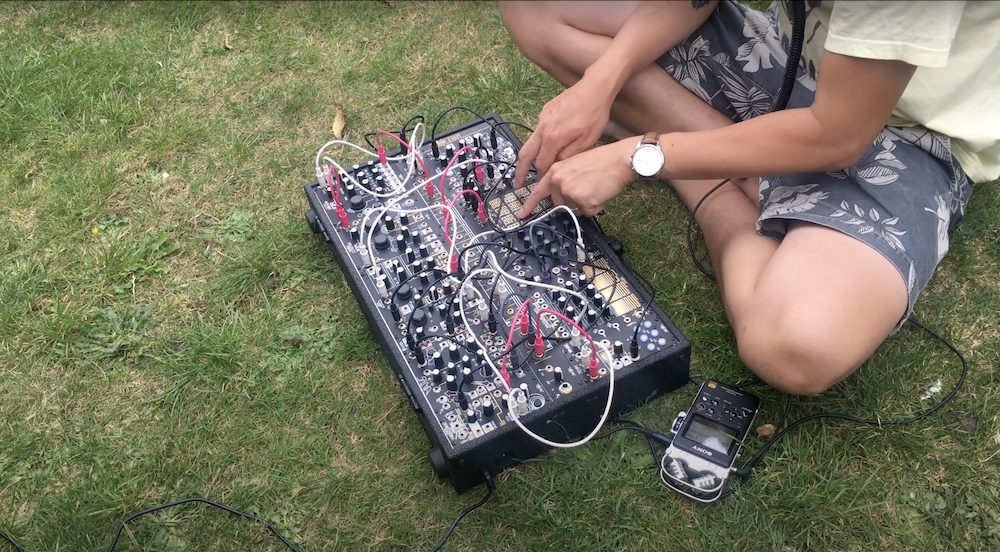
Anyway, multiple releases later and a handful of live shows (including a live session on BBC introducing), I’d kind of tired of the sounds I was composing with the system, I also found the newer Make Noise modules increasingly complex and operating the system as an instrument became more a memory challenge of button combos (I was good at this with Ken in Street Fighter 2, but sadly my short term memory is not what it was in the early 1990’s). It seemed every time I updated to a newer module (for example Phonogene → Morphagene, Rene v1 → v2, Echophon → Mimeophon etc etc) I enjoyed performing with the system less and less. Until finally it sat for many months, closed up in its case and I deliberated over selling it on numerous occasions, as I get intense guilt pangs if a piece of gear sits unused. I’m basically whatever the exact opposite of a hoarder is.
Locking shit down
During the first UK lockdown in 2020 I noticed an artist friend, who happens to live locally, was looking to buy some Make Noise modules and coincidently wanting to sell his Ciat Lonbarde setup. I was already familiar with the instruments online and had seen him perform live with the setup, so knew it sounded good loud, but other than that, I’d never laid my hands on any Ciat Lonbarde pieces (or banana synths in general). So after some lengthy discussions, we both agreed our systems were of similar monetary value and to save ourselves the painful song-and-dance of eBay selling, PayPal fees etc. We decided to swap systems, wholesale. His Ciat Lonbarde, for my Make Noise.
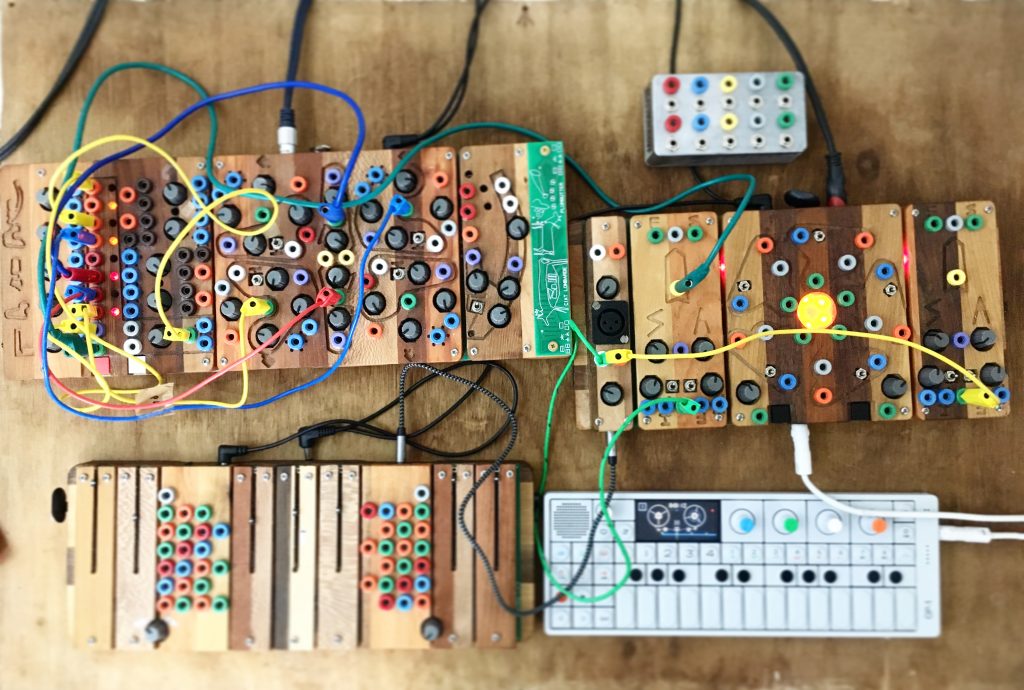
Magic Beans?
At first, I felt a bit like I’d gone to the market and swapped my (black &) golden cow for some magic (wooden) beans. But I’ve owned these noisy wooden boxes for a few months now and getting a handle on how they work and recording a motherload of tracks in the process. So in my eyes, synth inspiration (synthspiration?) is restored and these things are being used for their intended purpose (hey, synths are for music, not just instagram kids!). On the plus side, sonically, they are extremely well thought out, like a well tuned instrument, with individual elements of devices operating in distinct frequency ranges (see the various modules on the Plum Butter, for example).
I thought I’d give my rambling thoughts on these boxes (in total I got four Ciat Lonbarde devices in the swap) in a series of posts, as I begin to unravel their mysterious, yet intuitive, designs and entertaining, if slightly unorthodox, online ‘manuals’.
Crunchy Biscuits.
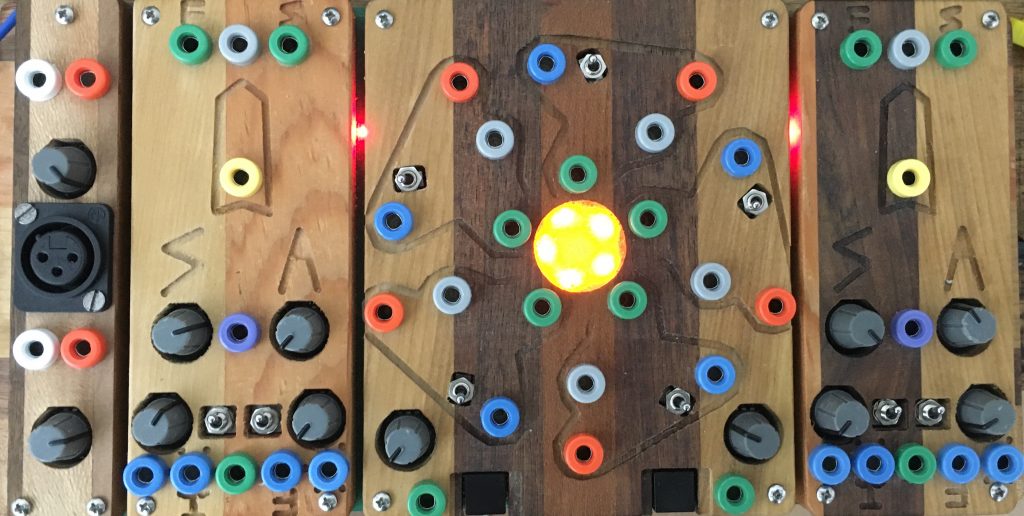
As I mentioned before, I really connected (no modular pun intended) with the earlier Make Noise modules, especially the Phonogene. It’s crunchy sonic nature and the mental aliasing it imparted on the recorded output was the basis of my ‘sound’ and the Make Noise module I thought I’d miss most. Thankfully not, as the Cocoquantus essentially has TWO Phonogenes (mono tape-style recorders), along with a chaotic matrix of five oscillators (aka ‘quantussy’) separating the two. I’d researched the Cocoquantus a fair bit prior to the swap and knew it was going to be in the same ball park sonically, but in fact the sound of the sampler(s) (possibly 8-bit?) when pitched down are so similar, I wonder if they are actually based on a similar processor?
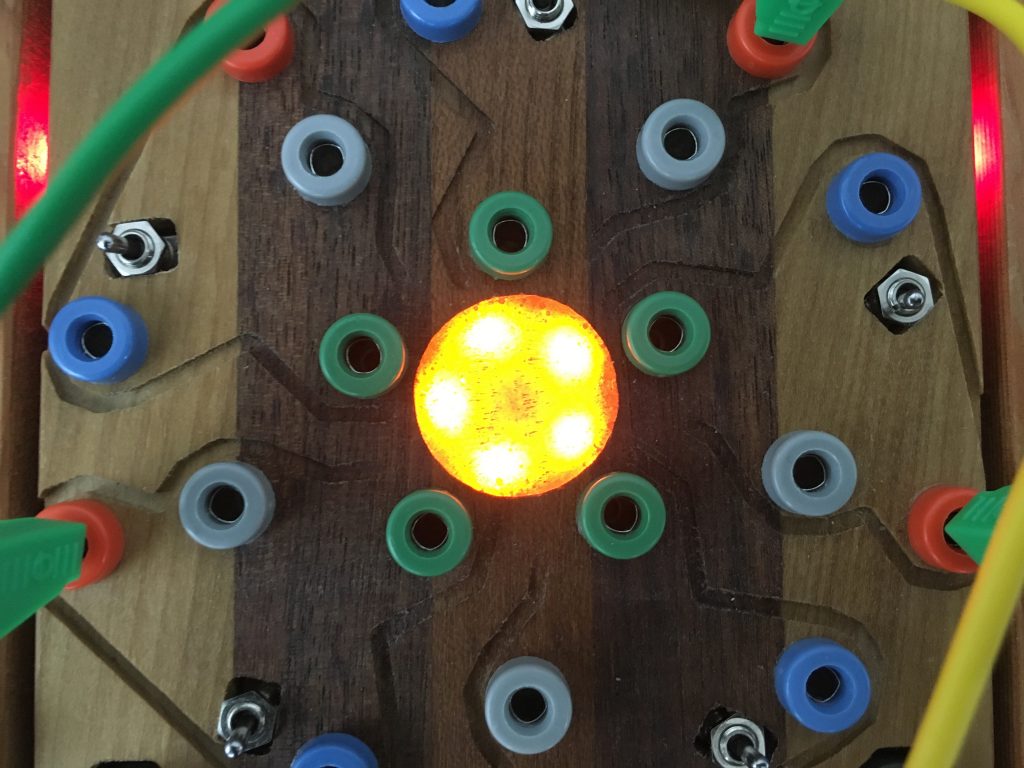
One of the composition techniques I gravitated towards with the Phonogene, is by starting a patch based around a grainy pitched down loop, using the end of cycle gate to sync my master clock to the loop and building the patch from there. So my first mission I set out to accomplish, was to try and recreate this workflow between the Cocoquantus and Plum Butter (a rhythmic synth I also obtained in the swap). So here is the first trick I’ve discovered, which appears to be completely undocumented anywhere online, but seems so obvious I’m surprised no-one has at least mentioned it somewhere?
Cocoquantus → Plum Butter (The Sanger Method).

To sync the Plum Butter to the Cocoquantus, it’s made simple (and rock solid) using the yellow ‘iron cross.’ output. If you connect this to audio, you can hear it generates a fairly wild harsh noise tone (or ‘secret sound’), which has it’s uses, of which are documented in various places online. However, connect this output to the green input of the plum butter sequencer ‘man with red steam’ and surprisingly (I say this as the tone it generates is not normally one I’d associate with a clock pulse anyway) the shift register clock will lock tightly to the length of the cocoquantus loop! The only caveat with this approach, is the Plum Butter only seems to pick up sync when the sample loop speed is reduced from its max value, this is no biggie as I always pitch my loops down to some degree anyway. nb make sure to ground your boxes together, as the sync goes a bit skewif if not!
So with these boxes obediently chugging along in tandem, it really opened up the possibilities of using them together. I mean, leaving everything completely unsynced is cool and all, but it’s nice to at least have the option of a master clock, should you need one!
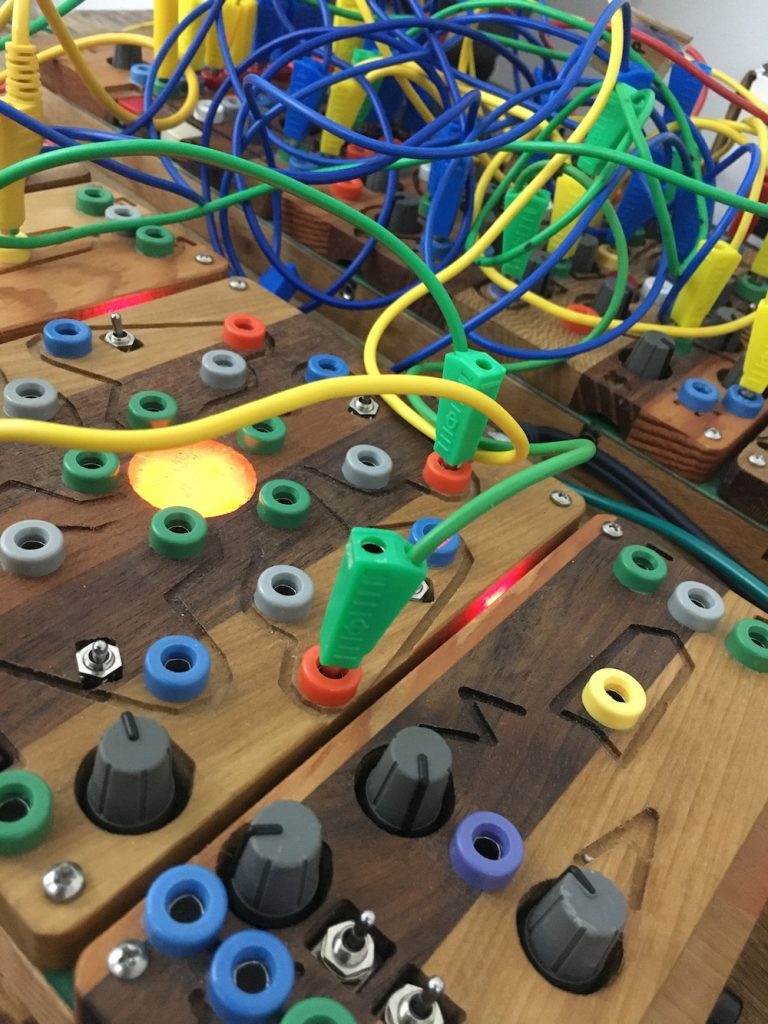
Banana Cross Pollination
I’ll talk more about the plum butter in it’s own post soon enough, but I’ll go on to say the cross pollination between the two devices goes far beyond simple clock sync. The chaotic matrix of oscillators provides useful modulation sources for the Plum Butter, which on its own, appears to lack some slow LFOs at least. This way I can get some nice synced looping between the two boxes, with lots of cross modulation, not a million miles from my old composition techniques in eurorack, except I’m getting sounds in the ballpark that resonate (accidental synth pun no.2) with me this time around, much quicker. On that note (groan) I think this kit certainly lends itself to ‘old school’ electronic music very well, which for me, is no bad thing. Basically simple sound sources, with complex modulation (ala Buchla, Serge et al).
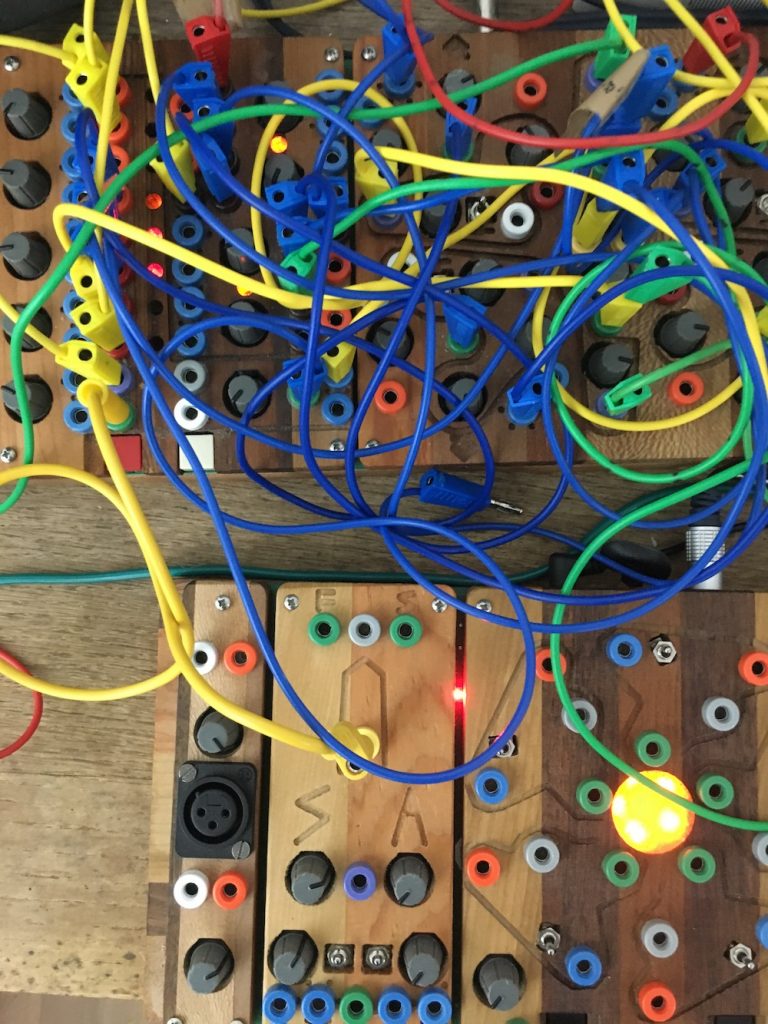
Anyway…
In short, I’m extremely content with the swap and the only thing I’ve missed from my Make Noise rig so far, is the attenuators they put on everything, there’s some modulation inputs on the Ciat Lonbarde I’d sometimes like to tame down a little here and there. But this is more likely user inexperience on my part, than design choices by the manufacturer.
